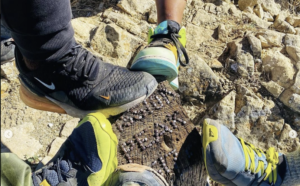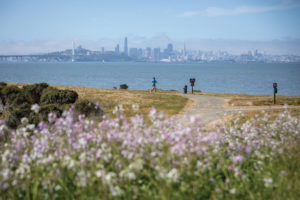As soon as my phone rang, I knew something was wrong. It was a Friday afternoon and I was sitting in my office at the newspaper where I worked in Seattle. My mother was calling, and I knew she wouldn’t bother me while I was at work unless she had a serious reason. Sure enough, my father had had a stroke. I told my boss I needed to go home and would be back the following week. I had no idea that I wouldn’t return.
When I arrived at Alta Bates Summit Medical Center in Berkeley the next day, a stone-faced neurologist told me that my father had a totally blocked carotid artery that was preventing vital blood flow to his brain, that another stroke was possible—perhaps imminent—and that nothing could be done. The next few days were a whirlwind of doctors, nurses, social workers, anxiety, and spontaneous sobbing.
But because I’m not someone who easily accepts being told “nothing can be done,” I began to brainstorm ways that I could help my dad, which led me to thinking about trees. As a journalist and avid hiker, I had been reading about studies that show exposure to nature decreases stress levels, lowers blood pressure, and reduces anxiety and depression, among other things. I also knew this to be true for myself.
So I tried to incorporate nature into my dad’s life. In his first few days in acute rehab, I tacked a poster of a redwood forest on his wall and arranged potted plants around his room. (One famous study published in Science in 1984 showed that patients recovering from a surgical procedure did so faster when they had a view of leafy trees compared to a view of a wall.)
But my father was in a daze, and no amount of plants, it seemed, could help speed up his recovery. When he was finally discharged from rehab weeks later, he could barely stand. The plants had mostly withered and died. Feeling helpless and without options, I quit my job and moved in with my parents in Berkeley to help take care of him.
Helping nurse my dad back to health was not easy, though the task was nothing compared to recovering from a stroke, which is an aggravatingly slow, nonlinear process. That was about a year and a half ago, and my dad can now walk a limited amount with a quad cane, but he doesn’t have much use of his left hand and mostly sticks to his wheelchair outside of the house. Intellectually, he’s as quick-witted as ever, but he’s also impulsive, easily distracted, and a bit forgetful. I can also tell he’s starved for nature: Whenever we go outside he tries to communicate with the towhees, the squirrels, the crows, the neighborhood cat, and the neighbor’s dog.
My dad has never been the outdoorsy type, but he has always had a love of plants, trees, and winged and furry creatures. So after he got home, and once he was less exhausted and more stable physically, I decided it was time to really get him outside. Nature has always been my salve, and I hoped it could provide him with some benefits, too. If nothing else, it would be something fun to do together. But while I’ve hiked plenty around the Bay Area, I’ve never done so while pushing a 74-year-old, six-foot, 175-pound stroke patient in a wheelchair (for comparison, I’m a five-foot-six, 125-pound woman). I wondered, just how accessible are East Bay parks?
I visited the East Bay Regional Park District’s accessibility page for guidance. It includes information on parks that have beach wheelchairs (Del Valle, Lake Temescal, Lake Anza), accessible playgrounds (Roberts Regional) and piers (Quarry Lakes), and pools with accessible lifts and changing rooms (Castle Rock, Roberts Regional). And while its “Trail Accessibility Reports” also contain very detailed information such as grade, cross slope, tread width, and trail surface, I’ll confess that none of it was useful to me. All I wanted to know before leaving the house: Was the trail flat enough and of a material that would allow me to easily push him? Are there bathrooms that have grab bars? Each park’s webpage has its own “Accessibility” section, which sometimes contains more helpful information than the technical specifications in the Accessibility Reports. And sometimes not.
So I emailed Carol Johnson, assistant general manager of public affairs at EBRPD, to see what tips she could offer. Johnson wrote back to tell me the district is “deeply committed to building and retrofitting our park amenities and trails to meet ADA standards….We spend over a half-million [dollars] annually exclusively on ADA compliance and retrofitting,” she wrote, “everything from benches to picnic tables, fishing docks, paved trails,” and more. As for advice on which trails are best for wheelchair hiking, she referred me to Bob Coomber, aka “4 Wheel Bob,” a Livermore city councilman, member of the parks advisory committee for the EBRPD, and an active wheelchair hiker. He’s also a strong advocate for making parks more accessible.
“I’ve pushed myself everywhere,” Coomber told me. He’s not kidding. His profile photo on Facebook shows the 62-year-old navigating a rocky trail. He was the first man in a wheelchair to summit 14,246-foot White Mountain Peak, the third highest mountain in California. A documentary about his hiking efforts called “4 Wheel Bob” was even released this year.
Coomber is obviously in much better physical shape than my dad—and, let’s be honest, than me, too. Although he’s been in a wheelchair for about 30 years, as a result of osteoporosis due to juvenile diabetes, he’s spent considerable time getting into tiptop physical shape to be able to navigate such challenging terrain. He gave me a list of parks that would be appropriate considering our limitations, told me to stick to trails with no more than a 5 percent grade, and recommended that I start lifting weights and, specifically, work my lower back, shoulders, legs, and trapezius muscles. So in the weeks leading up to our excursions, I did pushups, lifted tiny dumbbells, and did as many squats as I could.
Here’s what happened:
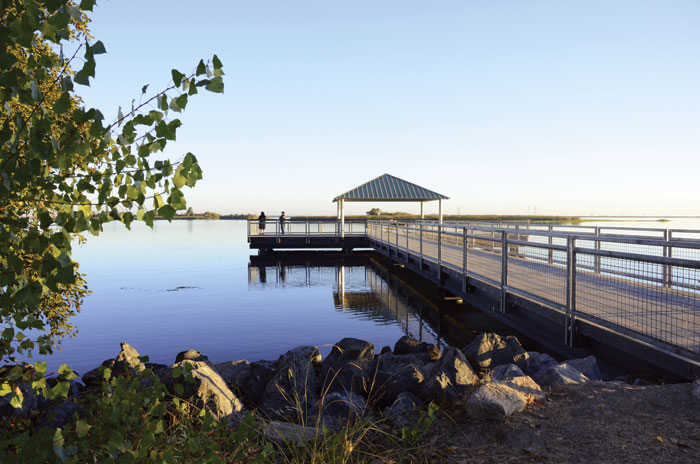
Big Break Regional Shoreline, Oakley
Big Break Regional Shoreline sits along a small estuary at the edge of the San Joaquin River, home to at least 70 species of birds. It’s also the location of the park district’s newest visitor center, opened in 2012, and a very flat, very accessible paved trail. It sounded like a great place to start. Getting there, however, was another matter.
It was a solid 45-minute drive east from Berkeley, even on a relatively traffic-free Saturday morning. When we arrived, I was already somewhat exhausted. Getting my dad down the stairs in our house is an effort in itself, and then there’s loading the wheelchair—and him—into the car.
When we finally arrived, we were greeted with a large, flat parking lot with plenty of spots, and I even found a shaded accessible parking space by an accessible bathroom. All seemed like good omens.
But as I got my father out of the car and into his wheelchair, I realized I had forgotten something crucial—his footrests. I thought we were going to have to turn around and go right back home, but I decided we should at least check out the visitor center—it was only about 100 yards away and then we would have explored something. Luckily, my dad was able to hold his feet up and off the ground until we got there, and two very helpful park employees assisted us inside. When I told them about our dilemma, they had the most amazing solution: a wheelchair with footrests that we could borrow! Yes!!
After my dad was transferred to the new wheelchair, we checked out the exhibits that give an overview of the Delta ecosystem and accompanying wildlife, then headed back outside to a short gravel path that led to a wide paved road. As we passed a small pond and low scrubby fields of Mexican sage, my dad marveled at the dragonflies, variety of birds, and various plants. At the waterfront, there was a giant relief map on the ground of the Delta region, as well as play areas, an accessible water fountain and bathrooms, shaded picnic tables, and a short pier. This is when I learned that my dad—who grew up in the Bay Area and has spent practically his entire life in the Oakland/Berkeley area—had never been to the Delta before.
“I’ve imagined this delta for a long time but I’ve never been here,” he said.
I was stunned.
I rolled him out to the pier and watched the swallows speed out from underneath, flitting above the water and darting after insects. My dad, who was somewhat of a birder as a kid, tried to figure out if they were cliff swallows. “See the yellow? That’s a distinctive mark,” he said. “I used to know all the swallows.”
After about 30 minutes, Dad was ready to go back, although there was more we could have explored. On our return, we saw a turtle slip into the pond and a hawk soar in the distance. At one point, the rustling of the cottonwood trees in the breeze and the che-weet che-weet che-weeting of the swallows gave me that warm, calm feeling inside. My dad seemed to have the same response. “That was nice,” he said, as we left.
When we got home, he wanted to see his bird book and we looked up swallows, trying to identify which ones we had seen. And then we both took naps.
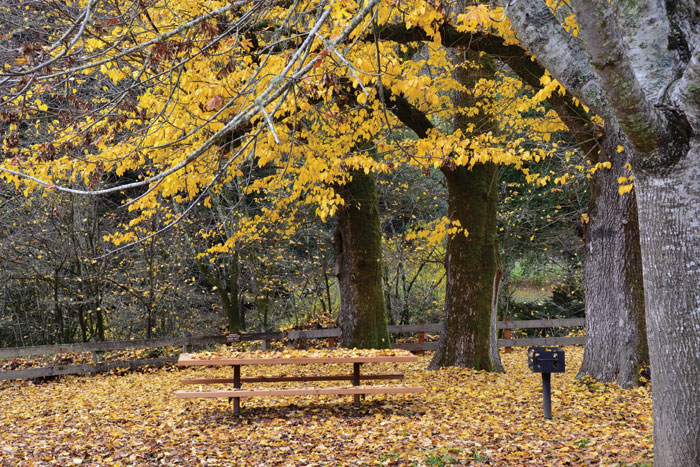
Redwood Regional Park, Oakland
Redwood Regional Park is thankfully much closer to home than Oakley, and although I’ve hiked this park many times, I hadn’t realized that a good portion of the trail from the main entrance is wheelchair accessible.
Knowing how crowded Redwood can get on the weekends, we went on a Tuesday morning. On this particular day in May, it was not only fairly empty but also downright cold. After finding an accessible parking spot in the lot, we took a paved trail into the park. My dad was immediately interested in the flora and fauna. He got excited when we saw some cute little black-capped chickadees on the trail and began chp chp chp chp chp chpping at them. He pointed out the blooming buckeye trees and made me take a picture of a bush with white flowers in order to identify it once we got home. We saw a rabbit, heard some turkeys in the distance, and admired the abundant patches of cow parsnip.
This is also where I learned that even the slightest grade can be exhausting when you’re essentially pushing dead weight (or a “sack of cement,” as my dad put it). The paved trail roughly follows Redwood Creek, passing by accessible bathrooms and water fountains, playgrounds and picnic areas before entering the second-growth redwood forest. It’s a lovely place to get under tree cover, and to a fully mobile person the trail probably feels very flat. But getting to Trail’s End—a campsite marking the end of the paved portion of the trail, which involved a small incline—took all my effort. By the time we got there, only about 0.9 miles from the parking lot, I was sweating and had to peel off my sweatshirt and jacket. Luckily, we found picnic tables and had a quiet view of the forest while I caught my breath.
Sitting in the peaceful solitude of the forest seemed to trigger my dad’s memories. He recalled a day camp in Oakland’s Dimond Park he attended as a kid and a subsequent hiking trip with his day-camp counselor and a friend to an area near the Eel River. The last time he had been to Redwood Regional was for the birthday of his best friend, who has since passed away.
I also noticed something else about my dad in the park: He said “hi” to everyone who passed by. It’s not that my dad isn’t friendly, but something about the shared experience of being outside seemed to elicit stronger feelings of camaraderie. (Studies have shown that exposure to nature can help foster empathy and strengthen social ties.)
When we came across a sign that read “no running or playing,” my dad responded, “What’s the use of going to a park if you can’t run or play?”

Castle Rock Regional Recreation Area, Walnut Creek
In a canyon adjacent to Diablo Foothills Regional Park lies Castle Rock, an exceedingly beautiful place, surrounded by golden hills dotted with oak trees and pronounced rocky outcroppings that reminded me of monuments. It feels worlds away and is one of the rare Bay Area parks where you can’t hear car traffic.
We went early on Memorial Day, when it was cool and a bit breezy. The parking lot is small, but there are two accessible parking spots right near the entrance of the trail. After I unloaded my dad, we took a wide, mostly flat, paved trail that follows Pine Creek. There are gentle inclines here and there but by then I had learned that a running head start makes them a lot easier to navigate. There were also plenty of picnic tables and accessible water fountains along the route, as well as a bathroom that was wheelchair accessible.
Castle Rock not only has peaceful views but also abundant birdlife, including bluebirds, mockingbirds, red-winged blackbirds, woodpeckers, and quail. For my dad, it was an opportunity to see some species he doesn’t often see on the other side of the hills.
But after not too long the paved road gave way to a dirt one, which made for a bumpier ride for my dad and a harder push for me. I’m a determined person, so we forged on through the dirt until it turned into a sandy consistency and it was clear the wheelchair wasn’t going any farther, which was fine, because not too many feet away were a cattle gate and a steep hill. As always, I was disappointed we couldn’t continue, but also somewhat relieved. We could go home.
“One day I’ll have to hike up there with you,” my dad said. I hoped that would be true.
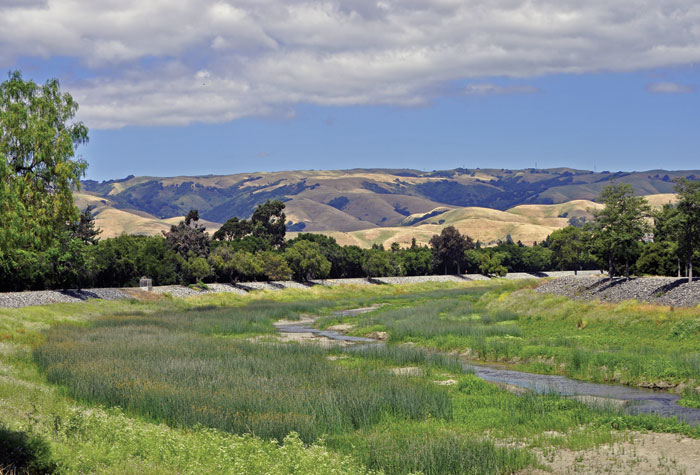
Coyote Hills Regional Park, Fremont
Coyote Hills was another park that neither of us had visited before, and although it’s a bit of a trafficky drive on a weekend morning from Berkeley, we were game to explore. Grass-covered hills rise up near the bayshore, surrounded by marshes filled with ducks and birds. After paying a $5 parking fee, we found an accessible parking spot in a dirt lot near the visitor center, where I picked up a map and asked a ranger about the most accessible and scenic route. (I took note of a wheelchair-accessible chemical toilet in the parking lot, and the visitor’s center also has an accessible bathroom stall.) Following his advice, we made our way onto the paved, mostly flat Bayview Trail, where we were treated to a beautiful view of the marshes and the East Bay hills. Almost immediately, a large deer appeared in the distance, leaping through the tall grass toward us. Dad wanted to “go say hello,” but a bicyclist came zipping down from the opposite direction, causing the deer to bound across the road and up a steep hillside.
Remember, they are an exotic species in the Western United States, and are rapidly increasing their geographic range and range of habitats. Are they outcompeting or excluding native species in the process? How would we know? We have done almost nothing to monitor changes in the assemblage of mushroom species in areas before and and after the incursion of death caps.
Further Reading
Pringle et al, “The ectomycorrhizal fungus Amanita phalloides was introduced and is expanding its range on the west coast of North America,” Molecular Biology 2009
Lockhart et al, “Simultaneous emergence of multidrug-resistant Candida auris on 3 continents confirmed by whole-genome sequencing and epidemiological analyses,” Clinical Infectious Diseases 2017
Battalani et al, “Aflatoxin B1 contamination in maize in Europe increases due to climate change,” Scientific Reports 2016
Accessible Resources:
- Access Northern California includes a long list of Bay Area trail descriptions.
- The blog “Adventures from a Wheelchair” also reviews trails around the Bay Area.
- “Wheelchair Rider’s Guide to the California Coast” is supported by the California Coastal Conservancy and up-to-date.
If you want to start learning about grades and how to interpret them, consider downloading an inclinometer—an instrument that can measure incline—app to a smartphone and bring it in the field with you to get a feel for what a 3 or 5 percent grade means.
We forged up a small incline as my dad took note of our surroundings: gulls crying in the distance, a plane making its way toward the Oakland airport, rocks that looked like they would tumble down the hill. He was fascinated by the geography of the area and stopped a man passing by to ask about the marshes. He told us they were freshwater and that the recent winter rains had flooded the area.
As lovely as the surroundings were, it quickly became apparent that our visit would be short. After struggling up one small hill, and seeing more in the distance, I decided to call it quits. I didn’t have the energy to continue, and although we could have explored other trails—including a boardwalk over the marshes—I decided that my efforts were somewhat futile. We could never make it very far in Coyote Hills as long as I was the one pushing him and he was in a manual wheelchair. What we really needed was a motorized scooter. (The park district allows power-driven mobility devices within certain guidelines.)
That’s not to say that our outings weren’t worthwhile. My dad seemed to reap the benefits of the outdoor exposure that I’d been advocating, while, ironically, I spent most of our hikes worrying. He had been much more present than I was on these excursions. I kept asking him whether he was too hot or too cold, whether he needed water or to use the bathroom—while he was pointing out all the different species of birds and flowers and trees. I thought he needed help enjoying nature, but he was doing just fine on his own. He only needed assistance getting there.
He’s eager to explore more parks, so I’ll keep up with the weight lifting, and next time we’re out there, I’ll try to let nature take its course.



